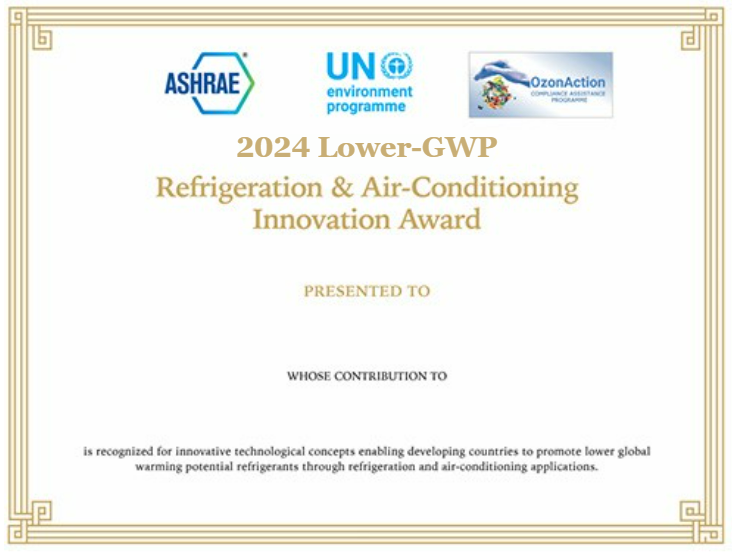
What Is the Lower-GWP Refrigeration and Air-Conditioning Innovation Award?

The award promotes innovative design and practice by recognizing people who have developed or implemented innovative technological concepts applied in developing countries to minimize the use of higher global warming potential (GWP) refrigerants through refrigeration and air-conditioning applications.
To be eligible, a project must have been implemented in a developing country. Developing countries are listed in Article 5, Paragraph 1 of the Montreal Protocol fund.
The next award selection will take place in fall 2024. Link to the entry form is found below. Deadline for submission is August 15. Projects will be recognized at UNEP and ASHRAE events and in their respective publications.
Innovation Award Selections
Four projects were selected for the 2023 ASHRAE–UNEP Lower GWP Refrigeration and Air-Conditioning Innovation Award. The selection process considered the innovative aspects in transforming conventional concepts, technical replicability in developing countries, extent of need, and economic feasibility in developing countries.
2023 Project Selections
2019 Project Selections
Who Are the Awarding Organizations?
The selected recipients will be recognized by ASHRAE and UN Environment Programme (UNEP) OzonAction.
How Often Is the Award Issued/Awarded?
The awards were last presented in 2023. The next awards will be presented for submissions made in 2024.
What Are the Award Categories?
Selection is made in two categories up to 5 selections per category:
- Residential Applications
- Commercial/Industrial Applications
A maximum of 5 projects are selected within each category. Each selection is named as earning an ASHRAE UNEP Lower GWP Innovation Award. Selections are not made as first place, second place, etc.
What Are the Entry Criteria?
The award promotes innovative design and practice by recognizing people who have implemented innovative technological concepts in developing countries to minimize global warming potential (GWP) of refrigerants.
The award is only open to individuals and to teams of individuals who were involved in the research, design or implementation of the technology used in the project. While one or more individuals may be involved through their work with institutions, private sector organizations, or firms, awards will only be made to and in the name of individuals. Recognition will not be made to their firms or other types of employers.
If submission is by an individual, individuals must confirm the work was not a team effort and must provide confirmation by a person familiar with the work.
If a team of individuals is selected for an award, a maximum of 5 certificates will be issued and a maximum of 5 individuals will be cited for each selected project. For larger teams, the applicant should specify the 5 names that will be cited.
How Do I Submit an Entry?
The submission form requires descriptive responses to each of the following:
- Goal of the design, practice or project. Must describe how a higher GWP refrigerant was replaced or its use avoided. Systems should be new designs operating with lower GWP refrigerants rather than conversions of existing systems. (Maximum 3,000 characters)
- Description of innovation in the field of air conditioning and refrigeration using lower-GWP refrigerants. Must be a new technology, be an innovative application in a developing country or demonstrate a new approach supporting lower GWP refrigerants rather than use of an innovative technology in a new market in the same way the technology is applied in developed markets. (Maximum 3,000 characters)
- Project implementation and safety details. Must be an implemented project, system, or application (not only research) with implementation year. Describe steps in implementation of innovation - including description of safety practices introduced, promoted, or supported to align with the chosen refrigerant. (Maximum 5,000 characters)
- Extent of need. Must describe the problem addressed or the challenge met in a developing country. (Maximum 2,000 characters)
- Environmental and energy impact. Must describe the beneficial environmental impact achieved including specific reference to the lower GWP refrigerant’s contribution. Must describe energy saving features. (Maximum 3,000 characters)
- Further application. Describe the benefit of applying innovation in other developing countries from technological, economic and social perspectives. (Maximum 4,000 characters)
- Financial feasibility. Must be financially feasible allowing replication in other developing countries. Compare fiscal performance to other systems to illustrate the innovation’s fiscal viability. (Maximum 3,500 characters)
Photographs illustrating the project and tables, figures, or charts that present statistical data demonstrating the project's successful performance or experimental findings are encouraged to be provided with the application. All documentation and materials must be submitted in English.
What Is the Entry Period?
The next award selection will take place in 2024. The entry period ends on 15 August 2024.
How Are the Projects Selected?
The selections in each category will be based on the following criteria:
- Innovative aspects in transforming conventional concepts (40%);
- Technical replicability to developing countries (25%);
- Extent of need (25%); and
- Economic feasibility to developing countries including energy efficiency (10%).
How Are Selected Projects Recognized?
In addition to certificates issued for each selected project, the projects are publicized by both organizations in a special ASHRAE-UNEP Press Release, Flyers and Posters, as well as presenting the selected projects at UNEP’s international and regional events.
Talking Points
Talking points for speakers visiting areas where the award is of interest are available  for download here.
for download here.
Frequently Asked Questions (FAQs) FAQs
Contact